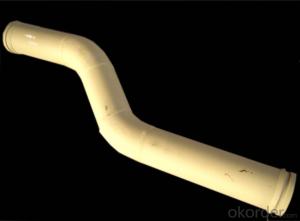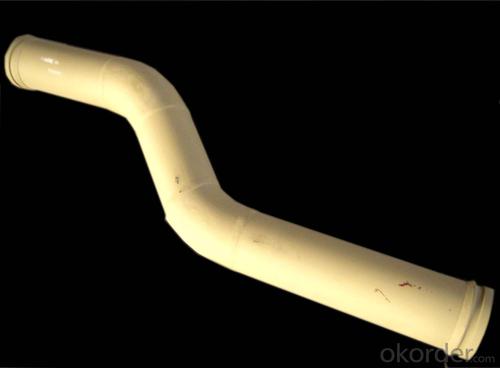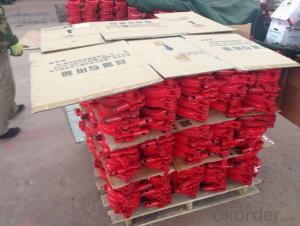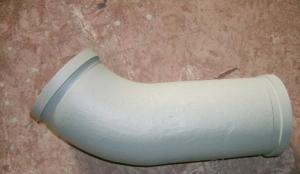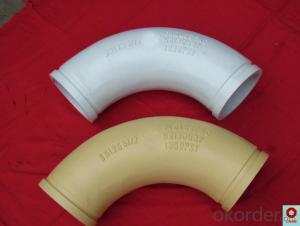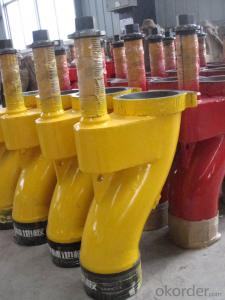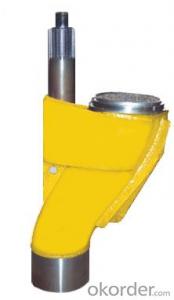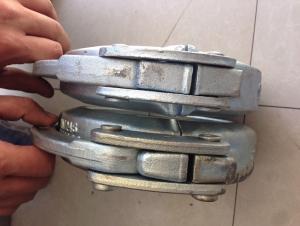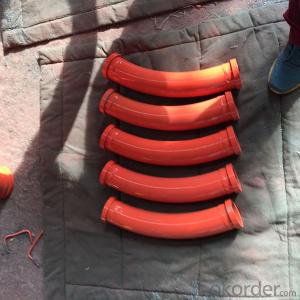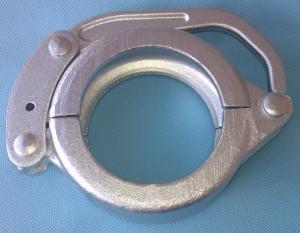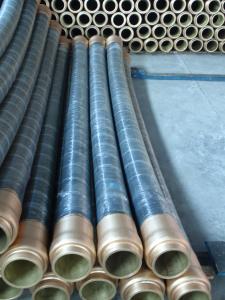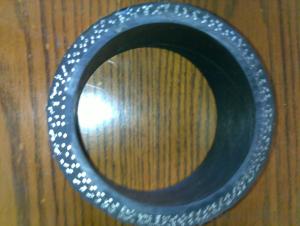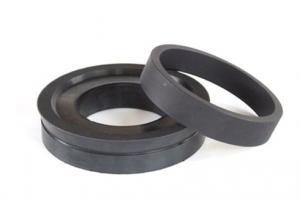PM S-TUBE 2*45degree for Putzmeister concrete Pump
- Loading Port:
- Tianjin
- Payment Terms:
- TT or LC
- Min Order Qty:
- 5 pc
- Supply Capability:
- 2000 pc/month
OKorder Service Pledge
OKorder Financial Service
You Might Also Like
Specifications
Concrete Pump Spare Part Elbow PM S-TUBE 2*45degree for Putzmeister concrete Pump
1.Length:1m-9m
2.Material:ST52,45Mn2,20#
3.Thickness:4mm-7mm
Concrete Pump Spare Part Elbow Pipe factory sales well in the world
1. Specification: DN125 , DN150
2. Service brand: PM, Schwing, Sany, Zoomlion...etc
3. Good material buy from state-owned company----Materical Certified
Concrete Pump Pipe | |||||||
Type | DN | WT (mm) | Length(s)(mm) | Companion Flange | (HRC) | Depth of hardness Layer (mm) | Application Life (CBM) |
Hardened | 125 | 4.5 | below 9 | 148(mm)Multiunit Flange | 60-65 | 2-2.5 | 20,000-30,000 |
Pipe | 4.85 | 148(mm)Multiunit Flange | 2-2.5 | 25,000-30,000 | |||
(45Mn2) | 5 | 148(mm)Multiunit Flange | 2.5-3 | 35,000-40,000 | |||
7 | 152-148(mm) Multiunit Flange | 3.0-4.0 | 40,000-50,000 | ||||
Common | 125 | 4.5 | below 9 | 148(mm)Multiunit Flange | 10 | 8,000 | |
Pipe | 4.85 | 148(mm )Multiunit Flange | 1,000 | ||||
(45Mn2) | 5 | 148(mm ) Multiunit Flange | 12,000 | ||||
7 | 152-148(mm) Multiunit Flange | 20,000 | |||||
Double | 125 | 2.5+2 | below 9 | 148(mm)Multiunit Flange | 60-65 | 2.5 | 40,000 |
Layer | 3+2 | 148(mm)Multiunit Flange | 3 | 50,000 | |||
Pipe (45Mn2) | 4+3 | 152-148(mm) Multiunit Flange | 4.5 | 70,000 | |||
Common | 125 | 4 | below 9 | 148(mm)Multiunit Flange | 60-65 | ||
Steel | 4.5 | 148(mm)Multiunit Flange | |||||
Pipe (20#) | 4.75 | 148(mm)Multiunit Flange | |||||
150 | 4.5 | 148(mm)Multiunit Flange | |||||
5 | 148(mm) Multiunit Flange | ||||||
Different kinds of concrete pump pipes
TYPE 1 Products:Welded Concrete Pump Pipe Size:DN125*133mm*4.5mm*3000mm DN125*133mm*4.0mm*3000mm Material:20# steel Using life (CBM):8000-15000 Highlights:Fit for Trailer-mounted pump only,Very Low TYPE 2 Products:ST52 Concrete Pump pipe Size:DN125 *133mm*4.5mm*3000mm DN125 *140mm*7.1mm*3000mm Material:ST52 Using life (CBM):15000-20000cubic meter Highlights:Real seamless and lower price TYPE 3 Products:Hardened Concrete Pump Pipe Size:DN125*133mm*4.5mm*3000mm DN125*140mm*7.1mm*3000mm Material:45Mn2 Using life (CBM):more than 30000 cubic meter Highlights:High wear resistance, very long life TYPE 4 Products:Twin wall Concrete Pump Pipe Size:DN125*133mm*4.5mm*3000mm (2mm+2.5mm) Material:Twin wall Using life (CBM):50000-60000 cubic meter Highlights:Two layers, the longest life-span
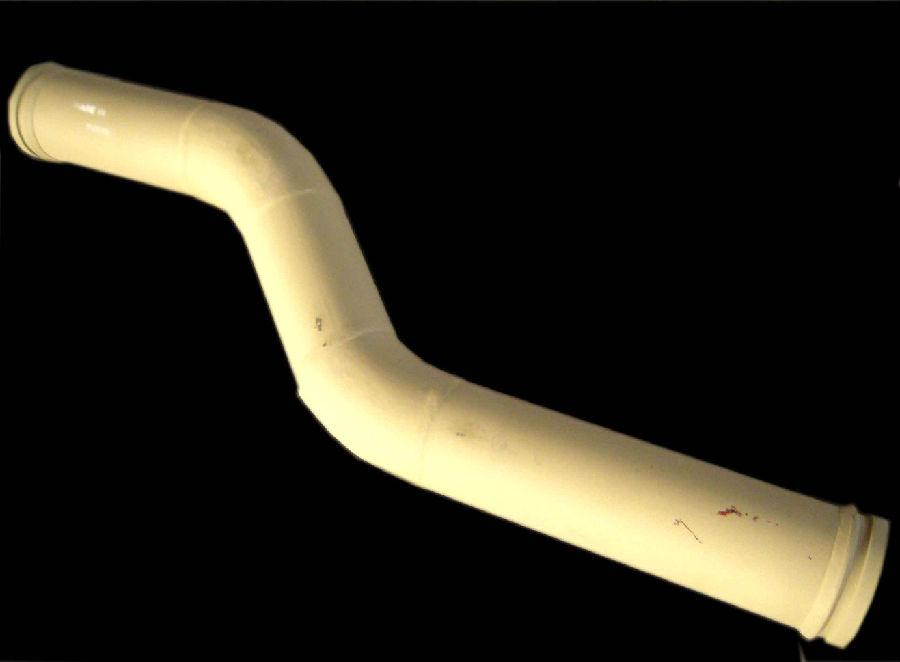
- Q: How often do I need to replace concrete pump spare parts?
- The frequency at which you need to replace concrete pump spare parts depends on various factors such as the quality of the parts, the usage intensity of the pump, and the maintenance practices followed. Generally, high-quality concrete pump spare parts can last for a longer time and may not require frequent replacements. However, if the pump is used extensively or in demanding conditions, the spare parts may wear out more quickly. To ensure the optimal performance and longevity of the concrete pump, it is essential to adhere to a regular maintenance schedule. This includes inspecting the spare parts for any signs of wear and tear, monitoring their performance, and replacing them as needed. It is advisable to consult the manufacturer's guidelines or seek professional advice to determine the specific replacement intervals for your concrete pump's spare parts. Keep in mind that neglecting proper maintenance or using low-quality spare parts can lead to more frequent replacements, which can be costly and disrupt your construction projects. Therefore, investing in high-quality spare parts and following a diligent maintenance routine will help maximize the lifespan of your concrete pump and minimize the frequency of replacements.
- Q: What is the purpose of a concrete pump hydraulic accumulator bladder?
- The purpose of a concrete pump hydraulic accumulator bladder is to store and release hydraulic energy within a concrete pump system. The bladder acts as a flexible barrier between the hydraulic fluid and a gas or air chamber. When hydraulic fluid is pumped into the bladder, it compresses the gas or air inside, storing potential energy. This energy can then be released when needed to power the hydraulic system, providing a surge of pressure and flow to ensure efficient and controlled movement of the concrete. The hydraulic accumulator bladder serves several important functions in a concrete pump system. Firstly, it helps to smooth out and regulate the flow of hydraulic fluid, reducing pressure fluctuations and ensuring a steady and consistent supply of power to the pump. This helps to prevent damage to the pump components and ensures a more reliable and efficient operation. Additionally, the bladder helps to compensate for variations in demand. As the concrete pump operates, there may be times when the demand for hydraulic power exceeds the supply. In such cases, the bladder can release the stored energy to meet the increased demand, providing a temporary boost to the hydraulic system. This helps to maintain a consistent and continuous flow of concrete, even during peak demand periods. Furthermore, the hydraulic accumulator bladder can also act as a safety device. In the event of a sudden pressure surge or spike in the hydraulic system, the bladder can absorb and dampen the excess pressure, preventing damage to the pump or other components. This helps to protect the equipment and ensure the safety of the operators. In summary, the purpose of a concrete pump hydraulic accumulator bladder is to store and release hydraulic energy, smooth out and regulate hydraulic fluid flow, compensate for variations in demand, and act as a safety device. By performing these functions, the bladder helps to optimize the performance and efficiency of the concrete pump system, ensuring a reliable and controlled movement of concrete.
- Q: What are the indications of a faulty concrete pump seal?
- There are several indications that can suggest a faulty concrete pump seal. Some of the common signs include: 1. Leakage: One of the most obvious signs of a faulty seal is leakage. If you notice any leaks around the seal area, it is a clear indication that the seal is not working properly and needs to be replaced. 2. Reduced pumping efficiency: A faulty seal can lead to reduced pumping efficiency. If you notice that the concrete pump is not able to deliver the same amount of concrete as it used to, or if it takes longer to complete a job, it could be due to a faulty seal. 3. Increased noise levels: Another indication of a faulty seal is an increase in noise levels during operation. If you notice any unusual or louder noises coming from the concrete pump, it could be a sign that the seal is not sealing properly and needs to be checked. 4. Vibration or movement: Faulty seals can also lead to excessive vibration or movement in the pump. If you notice that the pump is vibrating more than usual or if it is moving around during operation, it could indicate a problem with the seal. 5. Contamination: A faulty seal can allow contaminants such as dirt, dust, or water to enter the pump. If you notice any signs of contamination in the pump, it is important to inspect the seal and replace it if necessary. It is important to address any indications of a faulty concrete pump seal promptly to avoid further damage to the pump and ensure safe and efficient operation. Regular maintenance and inspection of the seal can help prevent potential issues and extend the life of the concrete pump.
- Q: What are the indications of a worn-out concrete pump clamp?
- There are several indications that a concrete pump clamp may be worn out and in need of replacement. Some common indications include: 1. Leaking: If you notice any leaking around the clamp area while the concrete pump is in operation, it could be a sign of a worn-out clamp. This leaking could be due to a faulty seal or gasket, which may no longer be able to create a tight and secure connection between the pump and the hose. 2. Vibrations and rattling: A worn-out clamp can cause excessive vibrations and rattling during the pumping process. This could be due to the clamp no longer being able to hold the hose firmly in place, leading to movement and instability. 3. Difficulty in tightening: If you find that it is increasingly difficult to tighten the clamp properly, it may indicate that the clamp is worn-out. Over time, the clamp's components can become worn, making it harder to achieve a secure and tight connection. 4. Visual signs of damage: Inspect the clamp for any visual signs of damage, such as cracks, dents, or corrosion. These physical damages can compromise the clamp's ability to function effectively, leading to potential leaks or instability. 5. Excessive wear and tear: If you have been using the same concrete pump clamp for an extended period without replacement, it is advisable to inspect it regularly for signs of excessive wear and tear. This could include worn-out or missing bolts, a deformed clamp body, or any other visible signs of deterioration. It is essential to address any indications of a worn-out concrete pump clamp promptly to ensure the safety and efficiency of the pumping operations. If you observe any of these signs, it is recommended to consult a professional or replace the clamp to avoid potential accidents or disruptions in the concrete pumping process.
- Q: How can one determine the correct viscosity and temperature range for lubricants used in concrete pump spare parts?
- Determining the appropriate viscosity and temperature range for lubricants used in concrete pump spare parts requires the consideration of multiple factors. Below are some steps that can assist in determining the suitable viscosity and temperature range: 1. Refer to the manufacturer's recommendations: To begin with, consult the specific guidelines or recommendations provided by the manufacturer for the concrete pump spare parts. The manufacturer may specify the required viscosity and temperature range for the lubricants used in their equipment. 2. Gain a clear understanding of the operating conditions: It is essential to have a comprehensive understanding of the operating conditions in which the concrete pump spare parts will be utilized. Factors such as ambient temperature, pump speed, load, and pressure should be taken into account. These factors can significantly impact the viscosity requirements and temperature range of the lubricant. 3. Assess the performance characteristics of the lubricant: Different lubricants possess distinct performance characteristics that make them suitable for particular applications. Look for lubricants specifically formulated for heavy-duty tasks, offering excellent wear protection and displaying good thermal stability. These performance characteristics ensure that the lubricant can endure the demanding conditions of a concrete pump. 4. Viscosity requirements: The viscosity of the lubricant plays a crucial role in ensuring proper lubrication and safeguarding of the concrete pump spare parts. Heavy-duty applications generally require higher viscosity lubricants, while lighter loads may be better suited with lower viscosity lubricants. The viscosity requirements may also differ depending on the specific pump parts, such as bearings, gears, or seals. Referring to the manufacturer's guidelines and seeking advice from lubricant suppliers can help determine the ideal viscosity range for the concrete pump spare parts. 5. Consider the temperature range: The temperature range within which the concrete pump operates is another significant aspect to consider. Lubricants should be capable of maintaining their viscosity and performance across the expected temperature range. Extreme temperatures can cause lubricants to lose their effectiveness, potentially leading to equipment damage or failure. Consequently, it is important to select lubricants with a temperature range suitable for the operating conditions of the concrete pump. 6. Consult with experts: If uncertainty persists regarding the appropriate viscosity and temperature range, it is advisable to seek advice from lubricant manufacturers, suppliers, or industry experts. They can offer valuable insights and recommendations based on their expertise and experience with concrete pump spare parts. By adhering to the manufacturer's recommendations, comprehending the operating conditions, evaluating the lubricant's performance characteristics, and seeking professional advice, it becomes possible to determine the correct viscosity and temperature range for lubricants used in concrete pump spare parts. This will ensure optimal lubrication and extend the lifespan of the equipment.
- Q: How to deal with the blockage in the outlet of the distributing valve of the concrete pump?
- Usually the pumping system is suddenly interrupted and has abnormal sound. The device has a strong vibration, but there is no vibration in the pipe
- Q: How can I determine if the concrete pump cylinder needs replacement?
- To determine if the concrete pump cylinder needs replacement, you can perform a few inspections and tests. 1. Visual inspection: Look for any visible signs of wear and tear on the cylinder, such as cracks, dents, or corrosion. Additionally, check for any leaks or excessive hydraulic fluid around the cylinder. 2. Performance evaluation: Pay attention to the pump's performance during operation. If you notice a decrease in pumping efficiency, irregular flow, or decreased pressure, it could indicate a problem with the cylinder. 3. Pressure testing: Conduct a pressure test to determine if the cylinder can handle the required pressure. This can be done by isolating the cylinder and pressurizing it to a level higher than what it typically experiences during operation. If the cylinder fails to maintain pressure or shows signs of leakage, it may be time for a replacement. 4. Cylinder stroke measurement: Measure the stroke length of the cylinder during operation. Uneven stroke lengths can indicate internal damage to the cylinder and may require replacement. 5. Consultation with experts: If you are unsure about the condition of the cylinder, it is advisable to consult with professionals or experts in the field. They can provide you with a more accurate assessment and recommend the appropriate course of action, which may include cylinder replacement. Keep in mind that regular maintenance and inspections are crucial for the longevity and efficient operation of the concrete pump. It is always better to address potential issues early on to avoid further damage or accidents.
- Q: What are the types of concrete pumps?
- The pump body and the conveying pipe are made up of. It is divided into piston type, extrusion type and water pressure diaphragm type according to the structure
- Q: What is the importance of a concrete pump control valve?
- A concrete pump control valve plays a critical role in the operation of a concrete pump. It is an essential component that allows for precise and efficient control of the flow and pressure of the concrete being pumped. The importance of a concrete pump control valve can be understood by considering its various functions. Firstly, it regulates the flow of concrete from the hopper to the pumping cylinders. By adjusting the valve, operators can increase or decrease the flow rate to match the specific requirements of the project. This ensures that the right amount of concrete is being pumped, preventing wastage and optimizing productivity. Secondly, the control valve allows for precise control of the pressure in the pumping cylinders. By adjusting the valve, the operator can increase or decrease the pressure to maintain a consistent and steady flow of concrete. This is crucial in preventing blockages or clogs in the concrete pump system, which can lead to downtime and costly repairs. Furthermore, the control valve enables the operator to switch between different pumping modes, such as high-pressure pumping or low-pressure spraying. This versatility allows for the efficient execution of a wide range of concrete pumping tasks, from pouring foundations to spraying concrete for decorative purposes. In addition to its functional importance, a concrete pump control valve also contributes to the safety of the pumping operation. It allows operators to stop or reverse the flow of concrete in case of emergencies or equipment malfunctions. This feature ensures that any potential hazards are quickly addressed, minimizing the risk of accidents and injuries. Overall, the importance of a concrete pump control valve lies in its ability to provide precise control over the flow and pressure of concrete during pumping operations. It ensures efficiency, productivity, versatility, and safety, making it an indispensable component of any concrete pumping system.
- Q: How does a concrete pump clamp work?
- A concrete pump clamp is an essential component of a concrete pump that is used to secure and hold the concrete delivery pipeline in place. It works by tightly gripping the pipeline to prevent any movement or leaks during the concrete pumping process. Typically, a concrete pump clamp consists of two main parts: the clamp body and the wedge. The clamp body is usually made of durable steel and has a curved shape that is designed to fit around the pipeline. It is equipped with bolts or knobs that can be tightened or loosened to secure the clamp onto the pipeline. The wedge, on the other hand, is a piece of metal that is inserted into the clamp body. It is responsible for exerting pressure onto the pipeline when the clamp is tightened. By turning the bolts or knobs, the wedge is pushed further into the clamp body, causing it to squeeze the pipeline tightly and create a firm grip. The tight grip created by the concrete pump clamp is crucial as it ensures that there are no leaks or disruptions in the concrete flow. It helps to maintain a consistent and steady flow of concrete from the pump to the desired location. Additionally, the clamp also provides stability to the pipeline, preventing it from moving or shifting during the pumping process. Overall, a concrete pump clamp plays a vital role in the efficient and safe operation of a concrete pump. It ensures that the concrete delivery pipeline remains securely in place, allowing for a smooth and uninterrupted concrete pumping process.
Send your message to us
PM S-TUBE 2*45degree for Putzmeister concrete Pump
- Loading Port:
- Tianjin
- Payment Terms:
- TT or LC
- Min Order Qty:
- 5 pc
- Supply Capability:
- 2000 pc/month
OKorder Service Pledge
OKorder Financial Service
Similar products
Hot products
Hot Searches
Related keywords
